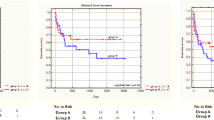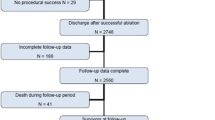Abstract
Catheter ablation has been shown to be an effective treatment for rhythm stabilization in patients with multiple ventricular arrhythmia episodes called electrical storm (ES). These procedures may be complex and are usually only performed in highly specialized and experienced centers. Still the optimum timing for catheter ablation in ES remains unclear.
Early access to perform acute ablation should be considered in patients who are not rhythm stabilized with antiarrhythmic medical treatment. Also patients with hemodynamic compromise (cardiogenic shock) are candidates for an early interventional strategy. In specialized centers it is consensus to perform catheter ablation in these patients as early as eligible especially when considering a high early and late mortality without interventional management. Establishing a structured protocol for treatment and admission to EP centers has helped to further reduce pre-ablation mortality and may optimize treatment of ES. Large scale networking to optimize and structure access to experienced electrophysiology centers is of importance to create a basis for optimizing treatment strategies.
Zusammenfassung
Die Katheterablation bei Patienten mit gehäuften anhaltenden ventrikulären Arrhythmien (elektrischer Sturm, ES) hat sich als effektive Therapie herausgestellt, ein möglichst frühzeitiger Zugang zur Ablation erscheint gerade vor dem Hintergrund der hohen Spätmortalität und Rezidivraten sinnvoll. Der optimale Zeitpunkt für diese komplexe Prozedur ist allerdings noch unklar. Als komplexe Ablationsprozedur wird die Ablation bei ES nur in wenigen erfahrenen Zentren mit hoher Expertise durchgeführt. Initiale Versuche einer frühzeitigen Verlegung dieser Patienten in diese Zentren durch zuweisende Kliniken hat zu einer Verbesserung der Versorgung von Patienten mit ES geführt. Man kann ein frühzeitiges elektives Ablationsvorgehen noch innerhalb des stationären Erstaufenthalts nach Auftreten eines ES nach Rhythmusstabilisierung von einer Akut-Ablation, durchgeführt zur Rhythmusstabilisierung, unterscheiden.
Innerhalb einer Klinik sollte eine Stufenplan zur Festlegung der Behandlungsstrategie erarbeitet werden. Aktuell wird in einem überregionalen Netzwerk von interventionellen elektrophysiologischen Zentren in Bayern ein Etappen-Therapie-Plan entwickelt, der unter anderem auch die Katheterablation als essentiellen Bestandteil beinhaltet. Im Rahmen der einzelnen teilnehmenden Zentren ist eine optimierte Versorgung der ES-Patienten mittels invasiver kardiologischer Therapieoptionen inklusive der interventionellen Elektrophysiologie initiiert. Somit wird versucht, flächendeckend diesen Patienten ein frühzeitiger Zugang zur Katheterablation zu ermöglichen.
Insgesamt erscheint somit ein Netzwerk kooperierender Kliniken zur Optimierung und Strukturierung des Zugang zu erfahrenen elektrophysiologischen Zentren entscheidend als Basis einer optimierten Therapiestrategie.


Similar content being viewed by others
References
Carbucicchio C, Santamaria M, Trevisi N, Maccabelli G, Giraldi F, Fassini G, Riva S, Moltrasio M, Cireddu M, Veglia F, Bella Della P (2008) Catheter ablation for the treatment of electrical storm in patients with implantable cardioverter-defibrillators: short- and long-term outcomes in a prospective single-center study. Circulation 117:462–469
Exner DV, Pinski SL, Wyse DG, Renfroe EG, Follmann D, Gold M, Beckman KJ, Coromilas J, Lancaster S, Hallstrom AP, AVID Investigators (2001) Antiarrhythmics versus implantable defibrillators. Electrical storm presages nonsudden death: the antiarrhythmics versus implantable defibrillators (AVID) trial. Circulation 103:2066–2071
Deneke T, Lemke B, Mügge A, Shin D-I, Grewe PH, Horlitz M, Balta O, Bösche LI, Lawo T (2011) Catheter ablation of electrical storm. Expert Rev Cardiovasc Ther 9:1051–1058. http://eutils.ncbi.nlm.nih.gov/entrez/eutils/elink.fcgi?dbfrom=pubmed&id=21878049&retmode=ref&cmd=prlinks
Izquierdo M, Ruiz-Granell R, Ferrero A, Martínez A, Sánchez-Gomez J, Bonanad C, Mascarell B, Morell S, García-Civera R (2012) Ablation or conservative management of electrical storm due to monomorphic ventricular tachycardia: differences in outcome. Europace 14(12):1734–17349
Deneke T, Shin D-I, Lawo T, Bösche LI, Balta O, Anders H, Bünz K, Horlitz M, Grewe PH, Lemke B, Mügge A (2011) Catheter ablation of electrical storm in a collaborative hospital network. Am J Cardiol 108:233–239
Kozeluhova M, Peichl P, Cihak R, Wichterle D, Vancura V, Bytesnik J, Kautzner J (2010) Catheter ablation of electrical storm in patients with structural heart disease. Europace 13:109–113
Kolettis TM, Naka KK, Katsouras CS (2005) Radiofrequency catheter ablation for electrical storm in a patient with dilated cardiomyopathy. Hellenic J Cardiol 46:366–369
Marrouche NF, Verma A, Wazni O, Schweikert RA, Martin DO, Saliba W, Kilicaslan F, Cummings JE, Burkhardt DJ, Bhargava M, Bash D, Brachmann J, Guenther J, Hao S, Beheiry S, Rossillo A, Raviele A, Themistoclakis S, Natale A (2004) Mode of initiation and ablation of ventricular fibrillation storms in patients with ischemic cardiomyopathy. J Am Coll Cardiol 43:1715–1720
Nademanee K, Taylor R, Bailey WE, Rieders DE, Kosar EM (2000) Treating electrical storm: sympathetic blockade versus advanced cardiac life support-guided therapy. Circulation 102:742–747
Compliance with ethical guidelines
Conflict of Interest
T. Deneke, P. Müller, J. Krug, K. Nentwich, D. Shin, P. Grewe, A. Mügge, A. Schade state that there are no conflicts of interest.
The accompanying manuscript does not include studies on humans or animals.
Author information
Authors and Affiliations
Corresponding author
Rights and permissions
About this article
Cite this article
Deneke, T., Müller, P., Krug, J. et al. Catheter ablation in patients with electrical storm: benefit of a network of cooperating clinics. Herzschr Elektrophys 25, 105–108 (2014). https://doi.org/10.1007/s00399-014-0306-x
Published:
Issue Date:
DOI: https://doi.org/10.1007/s00399-014-0306-x




